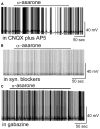Identification of both GABAA receptors and voltage-activated Na(+) channels as molecular targets of anticonvulsant α-asarone
- PMID: 24653701
- PMCID: PMC3949418
- DOI: 10.3389/fphar.2014.00040
Identification of both GABAA receptors and voltage-activated Na(+) channels as molecular targets of anticonvulsant α-asarone
Abstract
Alpha (α)-asarone, a major effective component isolated from the Chinese medicinal herb Acorus tatarinowii, is clinically used as medication for treating epilepsy, cough, bronchitis, and asthma. In the present study, we demonstrated that α-asarone targets central nervous system GABAA receptor as well as voltage-gated Na(+) channels. Using whole-cell patch-clamp recording, α-asarone inhibited spontaneous firing of output neurons, mitral cells (MCs), in mouse olfactory bulb brain slice preparation and hyperpolarized the membrane potential of MCs. The inhibitory effect of α-asarone persisted in the presence of ionotropic glutamate receptor blockers but was eliminated after adding a GABAA receptor blocker, suggesting that GABAA receptors mediated the inhibition of MCs by α-asarone. This hypothesis was supported by the finding that α-asarone evoked an outward current, but did not influence inhibitory postsynaptic currents (IPSCs). In addition to inhibiting spontaneous firing, α-asarone also inhibited the Nav1.2 channel, a dominant rat brain Na(+) channel subtype. The effects of α-asarone on a defined Nav1.2 were characterized using transfected cells that stably expressed the Nav1.2 channel isoform. α-Asarone displayed strong tonic inhibition of Nav1.2 currents in a concentration- and membrane potential-dependent fashion. α-Asarone reduced channel availability in steady-state inactivation protocols by enhancing or stabilizing Na(+) channel inactivation. Both Na(+) channel blockade and activation of GABAA receptors provide a possible mechanism for the known anti-epileptic effects of α-asarone. It also suggests that α-asarone could benefit patients with cough possibly through inhibiting a Na(+) channel subtype to inhibit peripheral and/or central sensitization of cough reflexes.
Keywords: GABAA receptors; anticonvulsant; central nerve Nav1.2 channel; olfactory bulb; sensitization of cough reflexes; sodium channel blocker; α-asarone.
Figures






References
-
- Chinese Pharmacopoeia Committee (2010). Pharmacopoeia of the People’s Republic of China, Vol. 1. Beijing: Chemical Industry Press
Grants and funding
LinkOut - more resources
Full Text Sources
Other Literature Sources

